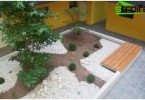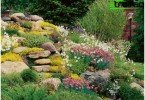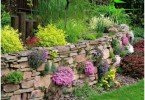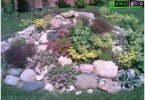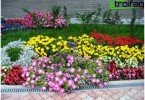How to make a picket garden from your own hands
Remember where the theater begins? With the hanger! And where does your site begin? That’s right, from the front garden! Over the years, the attitude to this small plot in front of the house has undergone changes. Previously, he was treated as a place where you can plant flowers and put a bench. Today it has become a distinctive hallmark of the garden plot. It shows the result of the work of the owner of the house and his aesthetic perception of the world. The best part is that creating a front garden with your own hands is quite simple. Thanks to special tools and a lot of information on the Internet, you can make this piece of landscape completely unique. Typical projects in this matter, as a rule, are absent. And this is good! After all, every gardener has the opportunity to show his skill and imagination.
Content
- Varieties of front gardens
- German style front garden
- Japanese style front garden
- We give credit to the classics
Varieties of front gardens
All household plots have their own characteristics. This is reflected in the design of the territory in front of the house. It can be of two types:
- Open. The space in front of the house in this case does not have a fence. It is open to the public, both from the porch of the building, and from the road. A typical version of this front garden is a carefully trimmed lawn with flower beds. It is crossed by a path leading to the main entrance. The area is surrounded by an extremely low fence, which does not interfere with viewing..
- Closed. In this case, it is fenced off from the street with a hedge. Some owners prefer a fence – brick, forged, wicker, wooden, stone, etc. An example of this type of front garden can be considered a courtyard, which is surrounded by a high hedge. It does not allow outside noise or dust..
Looking at this decorative fence, you stop thinking about problems
Depending on their personal qualities, homeowners either flatter their ego or try to impress their neighbors. It largely depends on how they make the front garden with their own hands – the photos show that two different types are reflected in them:
- Russian type. Everything that is outside the windows of the house should, first of all, please the owner’s eye. The view from the road interests them less than the view from the windows of the mansion. Most likely, it will be a closed territory, fenced on all sides by a fence (perhaps not always deaf) or a thick green flowering hedge. Much attention is paid to the interior decoration of the front garden. It can be clay figures, wooden painted decor and a large number of lushly flowering flower beds.
- European type. Strict standards are used in it. They are reflected in the precise geometry of the lines of carefully trimmed lawns, shrubs and trees, as well as in the impeccable design of paths and flower beds. In most cases, an open type is used, allowing any passerby to enjoy not only pleasure, but also to assess the quality and level of garden design. On such a courtyard everything is thought out to the smallest detail, including the shape of the steps and the arrangement of pots with exotic plants.
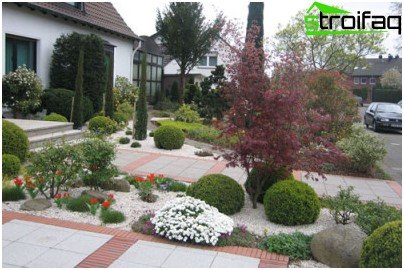
The European type of device for the front garden is characterized by impeccable forms
You can plan the design of your front garden, based on one of the styles – romantic, rustic, Japanese, Mediterranean, German, etc. We will dwell on some of them in more detail..
German style front garden
This simple and concise landscape design is suitable for those who prefer solitude and loneliness to a noisy company.
A German front garden is made from a picket fence, which performs a decorative function. Alternatively, it may not have a fence at all, which allows you to see all the plants in front of the house. They are chosen depending on the preferences, nature and type of activity of the owners. If you like neatly trimmed bushes of medium size and flowers of calm tones, then most likely you are a business person and enthusiastic about work. Creative natures choose brightly flowering plants and lush bushes like pink rose hips. Every resident of Germany can not imagine his house without a front garden or at least the vases standing in front of his entrance.
Japanese style front garden
If you are a person prone to asceticism and philosophy, then this style will suit you. The landscape design of such a site is so diverse that it can express the mood, taste and even social status of the owner.
The Japanese style respects the clarity and conciseness of forms. Stones and a small pond must be present. Preference is given to perennial herbaceous plants, which form the basis of the landscape design. Among flowers, a dominant position is given to irises, hellebore, astilbe and daylily. The main care is associated with the preservation of the initial forms of green space.
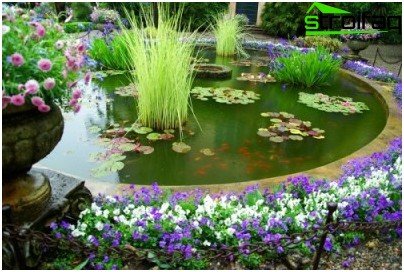
There is always room for a small pond in the Japanese garden
We give credit to the classics
The most important thing in the classical style is to choose a fence for the front garden or another fence that helps maintain a single style. Lovers of exuberant flowering and an abundance of colors can opt for country style.
- It is distinguished by the simplicity of the device and further care. Such a front garden is usually fenced with a wicker fence or picket fence..
- It looks great many familiar plants. We are talking about bells, peonies, panicled phlox, dahlia, gelenium, nasturtium. In the corner of the site, you can plant a funeral birch, but so that its branches do not obscure the too large area of the site.
- Near the tree, you can set a bench on birch logs and plant several bushes of mock-ups nearby. The earth near it is covered with bark. Hollow birch stumps are often used as special flower beds for bells. On the sides of the path laid out towards the garden, you can plant asters and phloxes.
- A feature of the classic front garden is its deliberate negligence. It is very simple to take care of it – it is enough to periodically weed and water the plants.
- Wattle is made of birch branches. Kryns and chopped cast-iron hang on it. If you put calistegia from the side of the street, then such a fence will look very impressive.
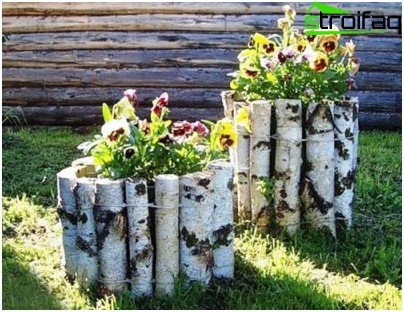
You can make a front garden cute with minimal means.
As you already understood, a combined approach is needed to create a front garden. You can use different design techniques and materials, as well as take into account the nuances of various styles. The main thing is that the site in front of your house harmonizes with it and looks as attractive as possible! We wish you success!



